An Owl Tour today. It was a nice start to the day, with a light frost and some sunshine first thing. It did cloud over during the day, but then the sun came out again late afternoon – good owling weather!
The day started with a drive round some grazing meadows which are regular hunting grounds for Barn Owls. With the bright start to the day, we thought this might have persuaded them to stay up, but it appeared they had gone in to roost already. We stopped for a short walk at one point, which did produce a nice selection of other birds. A Treecreeper feeding in an alder by the path, a flock of Long-tailed Tits moving quickly through the trees, Siskins flying over, a Little Egret and several Curlews feeding in a field.
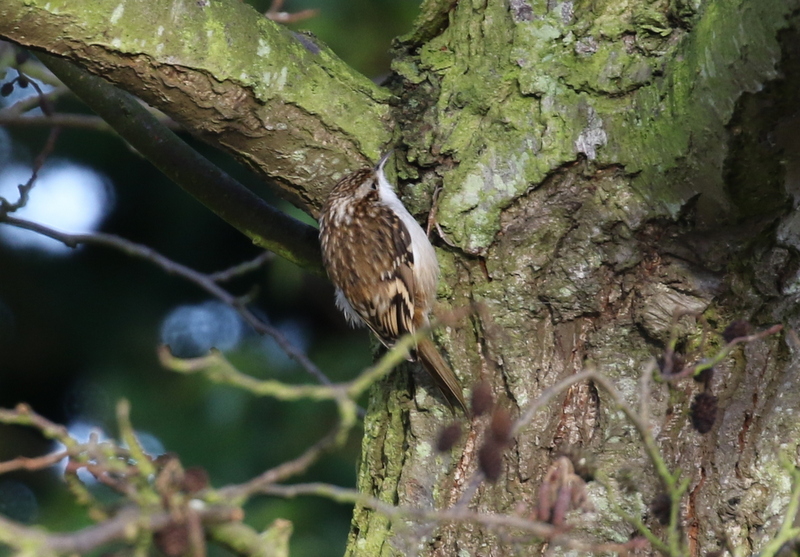 Treecreeper – feeding in the alders by the path this morning
Treecreeper – feeding in the alders by the path this morning
We decided to head off to look for Little Owls instead, in the hope we could still find one perched out enjoying the warmth after a frosty night. There was also a chance we might encounter a Barn Owl on our drive.
At the first set of barns we tried, we were in luck. Tucked up under the lip of the roof tiles was a Little Owl. We stopped some distance back along the road and got out of the car, so we could get it in the scope. We all had a good look at it, and with dog walkers going past without disturbing it, we decided to get a little closer. It stayed put, watching us, its feathers fluffed up.
 Little Owl – watching us from under the lip of a roof
Little Owl – watching us from under the lip of a roof
At one point the Little Owl hopped up and disappeared into the roof, under the tiles, but a few seconds later it came out again and resumed watching us. It seemed perfectly happy sitting out, despite the fact the sun had gone behind the clouds now. After a while, when it disappeared into the roof a second time, we decided to move on.
After our session with the Little Owl, the morning was getting on now, and it seemed less likely we would find a Barn Owl still perched out, particularly in the absence of the sun. Still, there is another complex of barns just a short distance from here and we thought it was worth a look anyway. It was lucky we did. As we pulled up in front, there were no owls perched around the barns but we looked up along the road to see a Barn Owl coming towards us, hunting the verges.
We hopped quickly out of the car, but it looked like the Barn Owl was heading directly in to roost, as it flew into the back of the barns. We were pleasantly surprised therefore when it flew straight through and out again on our side, where it landed on a wall right in front of us. Stunning views!
 Barn Owl – landed on a wall right in front of us
Barn Owl – landed on a wall right in front of us
The Barn Owl stood for a couple of minutes on the wall, looking round, seemingly unconcerned by our presence, before flying round and disappearing into one of the farm buildings to roost. We had got there just in the nick of time! While Barn Owls will regularly hunt during daylight hours if they need food, particularly at this time of year, they have not been doing it so regularly this winter. It may be because they are not hungry this year, possibly after rather mild and clement weather. To see one like this was therefore a real bonus.
That was a great way to start an Owl Tour – with such good views of Little Owl and Barn Owl already by this stage of the morning. As we stood reflecting on our fortune, a couple of Common Buzzards circled up out of a wood beyond and a Red Kite appeared over the field behind us. We decided to make our way back towards the coast.
As we drove through farmland, we saw several Brown Hares in the fields, reminding us that mad March is not far away now and ‘boxing’ season is almost upon us. We flushed several Bullfinches from the hedgerows as we passed, disappearing ahead of us with a flash of white rump. We did make one more stop on our way, at another regular site for Little Owls, but there was no sign of any here while we were there. We did see a couple of Stock Doves on the roof of one of the buildings. Given the great views of Little Owl we had already enjoyed, we weren’t too worried about not seeing another here and therefore didn’t linger long.
Down at Cley, there had been a Glaucous Gull in the meadows along Beach Road for the last couple of days. As we drove down towards the beach, there was no sign of it, just a first winter Great Black-backed Gull where it had been. We turned round in the car park at the end, noting the way the recent storm surge had pushed the shingle further into the parking area and beach shelter. As we drove back up the road a large pale shape appeared from the other side of the West Bank and flew over the road in front of us. It was the Glaucous Gull, right on cue.
The Glaucous Gull landed down on the grass, beside the Great Black-backed Gull. We found a convenient place to park and got out. The Glaucous Gull was completely unconcerned at our presence, and soon another couple of cars had joined us. We had great close-up views of it – a juvenile, pale biscuit coloured with paler wing tips and a distinctive pink-based, black-tipped bill.
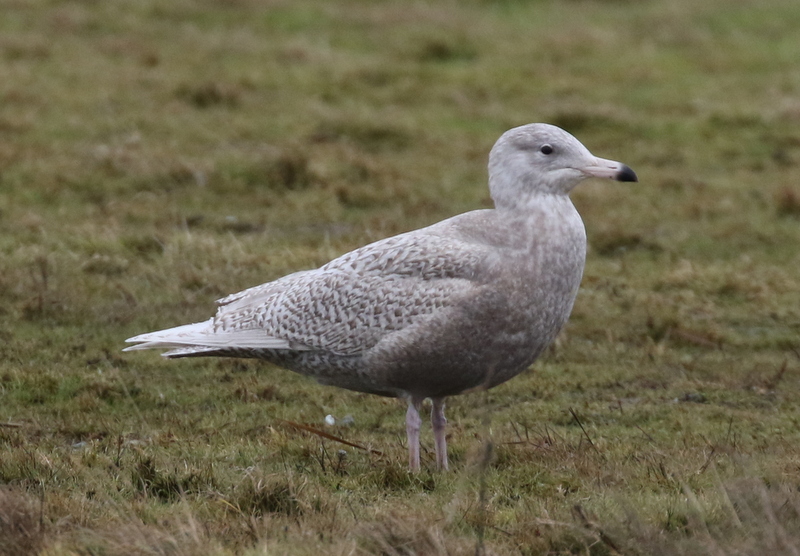 Glaoucous Gull – this juvenile showed very well by Beach Road
Glaoucous Gull – this juvenile showed very well by Beach Road
A big bruiser of a gull, Glaucous Gulls breed in the arctic. Several were blown south by strong northerly winds earlier in January and continue to delight the crowds here. This particular Glaucous Gull has apparently been feeding on the carcass of a dead seal, washed up after the floods. We decided to leave the gathering crowds and move on.
Round at the other side of Cley, we headed out for a walk along the East Bank. There were lots of Blackbirds alarm calling in North Foreland wood, but we couldn’t see what they were agitated by. A Grey Heron flew up out of the trees circled round and landed in the tops, and that seemed to calm them somewhat.
There were not so many ducks out on Pope’s Marsh and the Serpentine today, but still there was a nice selection. A smart drake Pintail woke up and swam out onto the water just to show off its long tail to us! Several Shoveler were asleep as were most of the Teal, but a couple of drakes were swimming around at the front of the Serpentine. But there was no sign of the Smew in with them today. A female Marsh Harrier circled round over the reedbed in front of us. We could hear Bearded Tits calling, and glimpsed them several times as they flew quickly over the tops of the reeds, but they didn’t come down to the ditch to bathe or drink today.
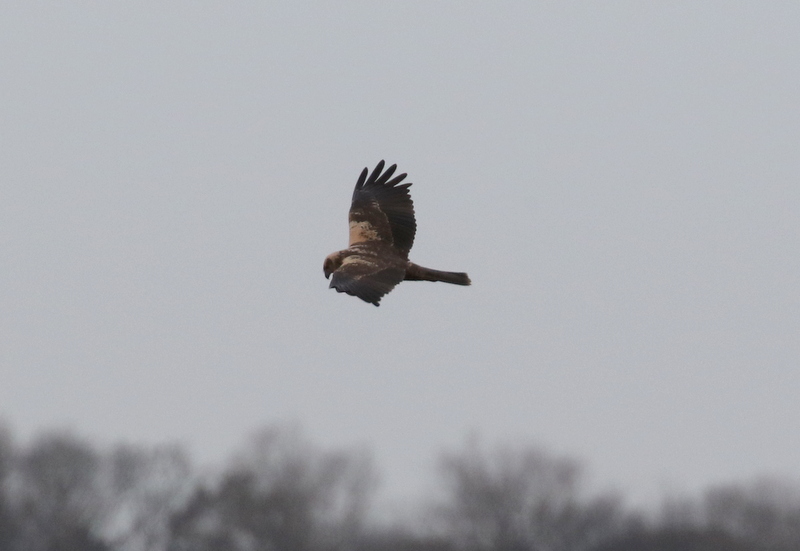 Marsh Harrier – a female, quartering over the reedbed
Marsh Harrier – a female, quartering over the reedbed
Arnold’s Marsh was full of waders. They were mostly Dunlin and Redshank, but we managed to find a couple of Ringed Plover in with them too. Over at the back, we could see lots of Gadwall and several Shelduck. A quick look at the sea produced a handful of Red-throated Divers and a Guillemot out on the water. As it was nearing lunchtime, we made our way back to the car. As we got back to the car park, a Tawny Owl hooted from North Foreland Wood. A nice surprise, though it is not that unusual to hear them hooting in the middle of the day sometimes.
We stopped for lunch at the Visitor Centre. We had a quick scan of the pools from the car park when we arrived, but could not see anything out of the ordinary. Some Black-tailed Godwits feeding on Simmond’s Scrape were a nice addition to the day’s list. However, while we were eating, one of the helpful staff from the Cley Spy shop next to the visitor centre came out and shouted across to us. The redhead Smew had appeared on Pat’s Pool – and he had spotted it from his vantage point higher up above us. We had a good look at it through the scope, swimming out on the water amongst the Shelduck. Then as quickly as it had appeared, the Smew disappeared from view again. A real bonus, with many thanks to Cley Spy staff!
After lunch, we made our way further east. We made a quick stop at the Iron Road to admire the large flock of Russian Dark-bellied Brent Geese feeding on the grazing marsh by Attenborough’s Walk. A Ruff was nearby on the wet grass, at least until it flew off, but not before we had a look at it through the scope.
 Brent Geese – feeding on the grazing meadows at Salthouse
Brent Geese – feeding on the grazing meadows at Salthouse
There has been a large flock of Pink-footed Geese feeding in a harvested sugar beet field at Weybourne for several weeks now. When we pulled up, we were glad to see there was still a good number here today, although possibly down a touch in total, but perhaps still a thousand or more. The Pink-footed Geese are characterised by their pink legs and feet, plus the pink band around their otherwise mostly dark bill. They come here in the winter in their thousands from Iceland, particularly to feed on the tops and bits of beet left over after the sugar beet has been harvested.
A quick scan through them revealed a couple of pairs of day-glo orange legs, a pair of Tundra Bean Geese. They are superficially very similar to the Pink-footed Geese, but the Tundra Bean Geese have bright orange legs and feet and an orange bank around the bill. We had a look at them in the scope, a great opportunity to compare side by side with the Pinkfeet. A careful scan of the flock also revealed another three Tundra Bean Geese further over, towards the back of the field.
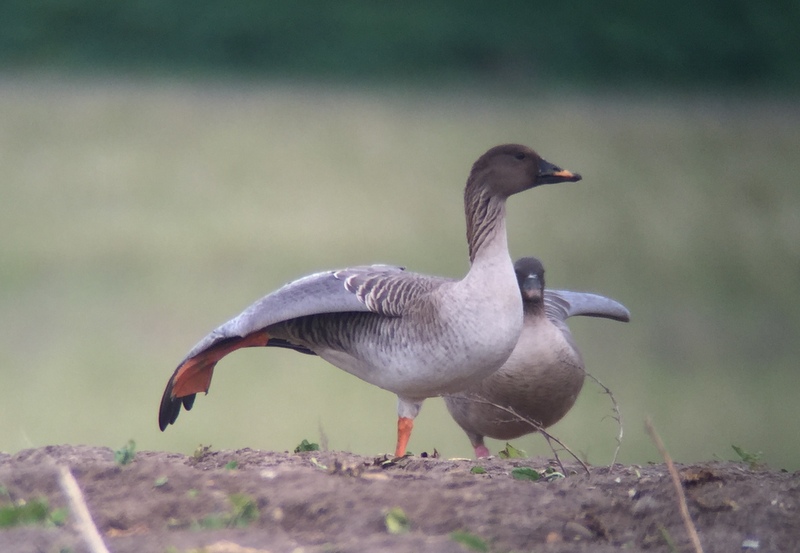 Tundra Bean Goose – in with a large flock of Pink-footed Geese
Tundra Bean Goose – in with a large flock of Pink-footed Geese
Tundra Bean Geese breed on the arctic tundra and winter mostly on the continent. We are at the western edge of the wintering range and get a variable number of them each year in with the bigger flocks of Pinkfeet. This has been a great winter for them, and they are always nice birds to see in the huge flocks of geese.
While we were watching the geese, all the Woodpigeons suddenly erupted from a neighbouring field. We looked up to see a Peregrine flying steadily across the field in front of us. All the geese looked distinctly unconcerned! The Peregrine flew down towards the cliffs, but then turned and came back past again. It was staring down intently and obviously thought it was on to something because it made another pass across the field and back again, before disappearing inland.
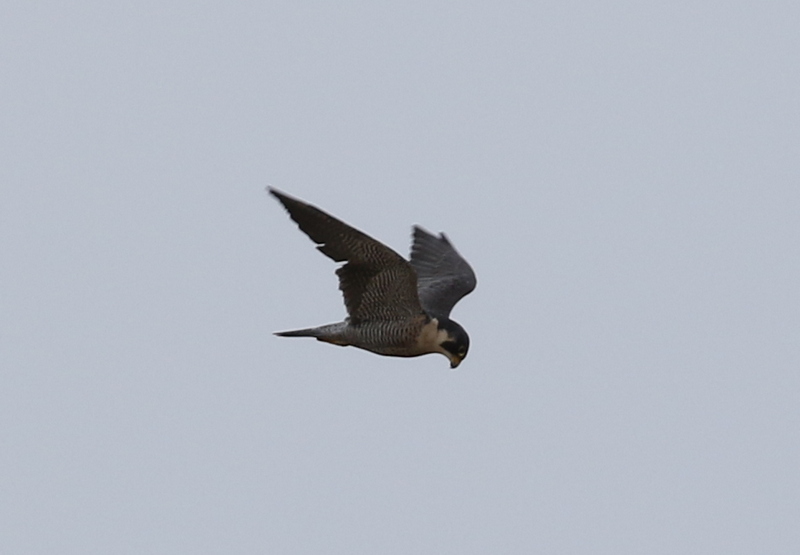 Peregrine – made several passes over the field in front of us
Peregrine – made several passes over the field in front of us
With one eye on the clock, it was getting on towards owl time again, so we made our way back along the coast to Blakeney. At the duckpond, the regular presumed hybrid Herring x Lesser Black-backed Gull was standing around waiting for feeding time. Darker backed than a Herring Gull, it is not as dark as a Lesser Black-backed Gull and its legs are an intermediate colour, neither pink nor yellow. It is a regular source of confusion for the unwary!
 Presumed hybrid Herring x Lesser Black-backed Gull – often at the duckpond
Presumed hybrid Herring x Lesser Black-backed Gull – often at the duckpond
As we walked out along the seawall, one of the group asked if there was any chance of seeing some Bearded Tits, having missed them at Cley earlier. We don’t often see them here but, just by coincidence as we were walking along, another birder called to us to say he was watching a group of Bearded Tits just a short distance further ahead of us. We were soon watching them too through the scope, feeding on the tops of the reeds, swinging around and clambering about in the stems.
 Bearded Tit – a male feeding in the reeds
Bearded Tit – a male feeding in the reeds
There were three Bearded Tits at first, two males with powder blue heads and black moustaches and a paler female. Then we heard calling and another pair flew in to join them. Great to watch! There were also a couple of Little Grebes and a Tufted Duck on the larger pool at Blakeney Barnett and a couple of Water Rails squealed unseen from the reeds.
Further along, we stopped at the corner and scanned the harbour. The tide was out and there were lots of waders on the mud. Amongst the masses of Dunlin on the near edge of the channel, we found a few Grey Plover and a single Knot. There were quite a few Black-tailed Godwits close to, but the Bar-tailed Godwits were further over, in the bottom of the Pit.
As the sun started to drop towards the west, it came out below the clouds and we were treated to some glorious winter afternoon light. Perhaps this would tempt the owls out early this afternoon? As we stood and scanned , we could see a Marsh Harrier perched on a bush out in the reeds. Another Marsh Harrier perched out on the saltmarsh the other side was bearing green wing tags but was unfortunately too far away to read the code. A Common Buzzard was perched on a bush nearby. Then we picked up a Barn Owl. It was a long distance away, across the other side of the Freshes, but we could see it as it flew up over the reeds and it seemed to be working its way round to our side.
While we were trying to keep tabs on the Barn Owl, we caught sight of another pale bird way off in the distance, flying low over the reeds. It was a male Hen Harrier. Thankfully it made its way steadily towards us, hunting low over the grass. It crossed the path ahead of us and did a circuit of the saltmarsh before cutting back and out across the Freshes again. It looked truly stunning in the afternoon sun, occasionally jinking from side to side and even flipping over at one point! Such a shame these magnificent creatures are still persecuted, such a delight to watch.
 Hen Harrier – a stunning male hunting in the afternoon sun
Hen Harrier – a stunning male hunting in the afternoon sun
After watching bewitched by the Hen Harrier for several minuted, when we looked back towards where the Barn Owl had been we couldn’t see any sign of it any more. However, while we were scanning we caught a half glimpse of a shape disappearing behind a bank low over the grass in the distance. It was a Short-eared Owl.
We walked quickly round to the other side to look for it and although there was no sign of it hunting one of the group quickly spotted the Short-eared Owl perched on a post. We just had enough time to get it in the scope and everyone had a quick look at it before it was flushed by some walkers on the bank ahead of us. It flew across the Glaven channel and started hunting along the edge of Blakeney Point. We watched it flying up and down, the distinctive rowing flight action on stiff wings, dropping down into the grass occasionally.
Time was getting on now. We had a long walk to get back to the car and an appointment with some Tawny Owls to keep. So we left the Short-eared Owl to its hunting and made our way back. We got to the woods just in time for the start of the evening’s activities, with a Tawny Owl hooting already just as we got out of the car, the earliest riser of the three regular hooting males here. We made our way round to the area where one the males has been roosting. After a short wait, we got a quick hoot from him, alerting us to where it was hiding. It had moved roosts again, back to where it had been a couple of weeks ago, high in the top of an ivy-covered tree. After a couple of minutes it flew out and landed on a bare branch briefly, before dropping back through the trees.
The Tawny Owl flew towards the other area where it likes to roost and it wasn’t long before we heard it hooting again. This time we managed to get it in the scope, although it was silhouetted against the last of the afternoon’s light. When it flew again – a surprisingly big and heavy owl on broad rounded wings – it landed much closer to us in the top of a tree, where we could see it perched. It then flew across in front of us and over the path, disappearing into the trees the other side. That might have been it, but a quick whistle and it flew back across the path again, perched up briefly, before dropping back away through the trees.
The light was fading fast now but, as we walked back to the car, we were serenaded by three different Tawny Owls hooting all around us. A great way to end a very successful Owl Tour.
















